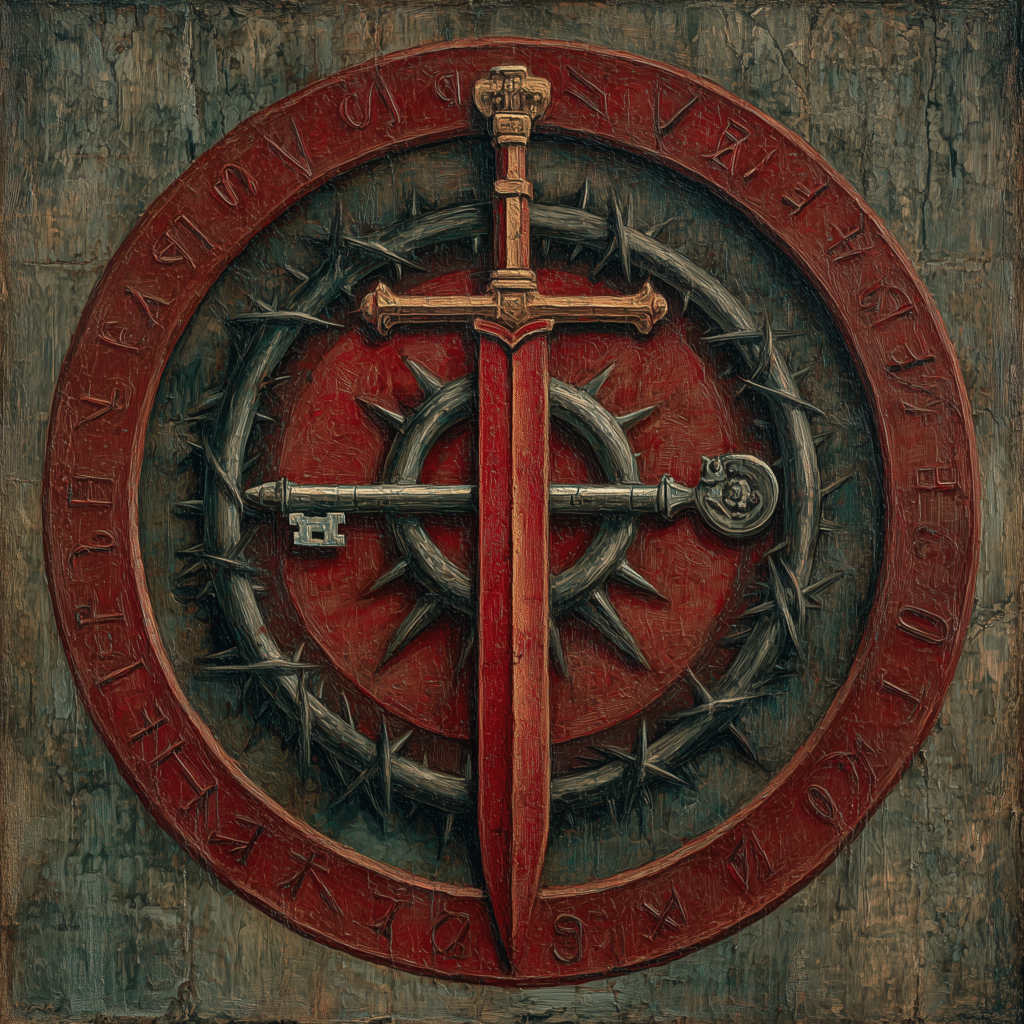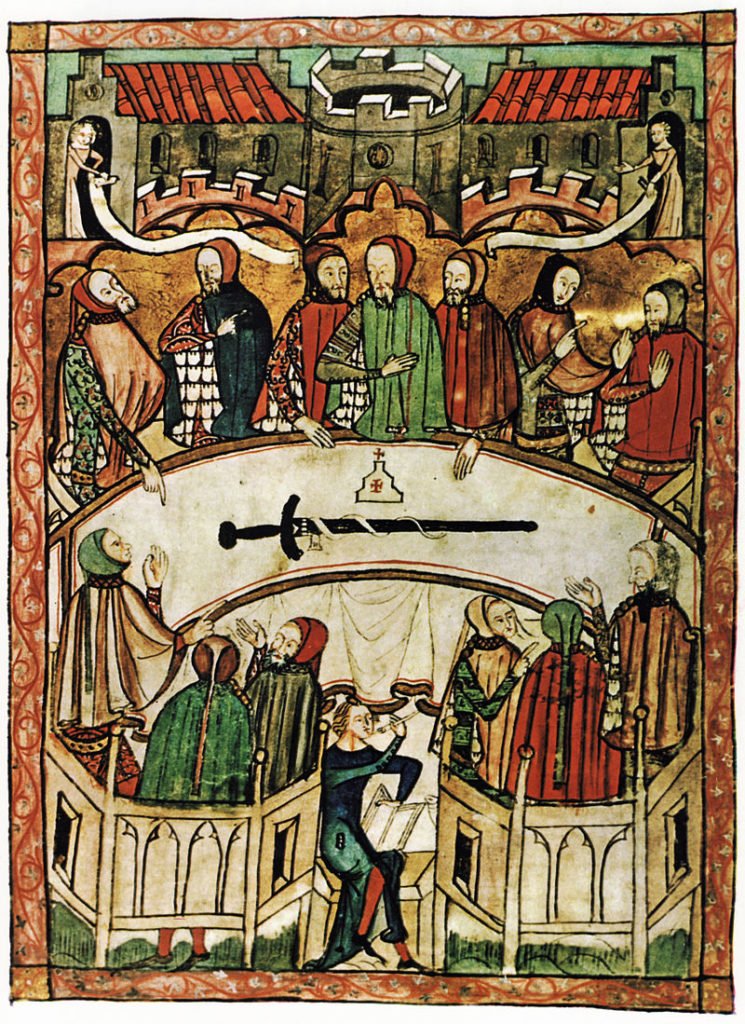The Silent Tribunal: The Hidden Hierarchy of the Vehmic Court
Uncover the dark legacy of the Vehmic Court — a secret tribunal where shadowy judges passed deadly sentences in the dead of night!

- Name – Vehmic Court (Die heimliche Gericht, “The Secret Court”)
- Symbol / Emblem – A crimson sword crossed over a silver key, framed by a circle of thorns; occasionally accompanied by the Imperial double-headed eagle to denote legitimacy.
- Motto or Slogan – “Justice Sees in Darkness” (Iustitia In Tenebris Videt)
- Type – Secret Society and Occult Judicial Order
- General Alignment – Lawful Neutral (with shades of Lawful Evil depending on the region or purpose)
- Purpose / Function – Publicly: To enforce Imperial law in lawless regions. Secretly: To judge, contain, or eliminate threats arising from unnatural pacts, heretical sorcery, inhuman entities, and forbidden knowledge.
- Founding Date / Origin – Circa 1180, under the reign of Emperor Frederick Barbarossa, in the wake of chaos following his reforms and the waning influence of centralized law.
- Founders – Imperial magistrates, Templar defectors, and an unnamed ecclesiast who allegedly communed with a bound celestial in Aachen.
- Beliefs & Core Values –
- The material world is tethered precariously to older, darker truths.
- Justice must be preserved even in the absence of light.
- Divine law applies not only to man, but to all beings that walk this world—seen or unseen.
- Silence and secrecy are sacred acts of service.
- Public Reputation – Feared, respected, and often denied. Nobles treat them as a dangerous but lawful force; the Church is divided. Among peasants, they are whispered of as night-judges, oath-bound ghost-slayers, or worse.
- Hidden Agenda (if any) – To prevent the Veil between this world and the next from thinning further. Some suspect they seek ancient relics to manipulate time-worn pacts sealed before the Flood.
- Leadership & Hierarchy –
- Stuhlherren (“Lords of the Seat”) – Cloaked figures known only by sigils and voice, who speak judgment over metaphysical or political matters.
- Freischöffen – Free Judges; senior operatives empowered to pass sentence.
- Zuhörer – Listeners or Initiates; apprentices who observe and learn, not yet permitted to speak in court.
- Messengers – Silent carriers of summons and tokens, often children or the tongueless.
- Number of Members – Estimated 1,200 to 1,500, though most remain dormant agents embedded in towns, priories, and noble households.
- Key Figures –
- The Black Stuhlherr of Münster – Rumored to have survived three centuries; wears iron gloves.
- Judge Elias of Soest – A former inquisitor who sentenced a demon-possessed bishop.
- Mother Annelind – Blind prophetess whose visions guide judgments, though she speaks only in riddles.
- Recruitment & Membership – Chosen through observation and omen; candidates are often survivors of supernatural events, heretical inquisitors, hedge-mages who renounce power, or soldiers who have killed something that bled light.
- Initiation Rites or Requirements –
- Swearing the Oath of Binding Silence.
- Standing judgment before a veiled tribunal.
- Viewing a sacred relic that reveals one’s truth.
- Sometimes a test involving a bound entity, a cursed object, or navigating a dream-ritual.
- Rules / Code of Conduct –
- Speak no judgment outside the Circle.
- Never deny the sign of the sword and key.
- Execute verdicts in secret, without cruelty, but without hesitation.
- Protect the Veil.
- Slay that which cannot be redeemed.
- Headquarters / Base of Operations – No fixed citadel; rumored “Seats” beneath ruined monasteries, caves beneath the Teutoburg Forest, and one drowned chamber beneath Aachen Cathedral.
- Territory / Sphere of Influence – Westphalia, the Rhineland, and portions of Thuringia; some agents travel through the Holy Roman Empire at large, including Bohemia and Bavaria.
- Allies – Selective Imperial magistrates, certain Templar remnants, hidden monasteries preserving forbidden texts, individual monks, anchorites, and wild hermits.
- Rivals / Enemies –
- Demonic cults, particularly the Cult of the Red Tongue
- Rogue mages who serve the Whispering King
- Radical Inquisitors who see the Vehm as blasphemers
- Fae courts displeased with mortal judgments
- Known Operations or Projects –
- The Silent Hunt of Lichtenau (1419)
- The Sigil Purge in Marburg (1427)
- Binding of the Mirror-Witch beneath Erfurt (1433)
- Containment of the “Weeping Gate” near Essen (1448)
- Funding / Resources – Discreet Imperial tithes, confiscated heretic property, ancient vaults beneath priories, and unknown benefactors—possibly non-human.
- Affiliated Organizations –
- The Black Library of Fulda (secret archive of blasphemous texts)
- The Iron Pilgrims (wandering exorcists bound to silence)
- The Ash Monks of Lorsch (keepers of the names of forgotten gods)
- Symbols in Use –
- Crimson sword over silver key on wax seals or hidden carvings
- Thorn-vine tattoos among initiates
- Black robes with interior linings of red, never shown publicly
- Stone medallions with unreadable glyphs used to open veiled paths
- Attitude Toward Outsiders – Suspicious. Tolerant only if the outsider serves purpose or carries a summons. Those who pry too deeply may be judged in silence.
- Customs & Rituals –
- Trials held in darkness with masked judges
- Offerings of wine and salt to ancestral dead before sentencing
- Midnight gatherings on solstices to renew oaths
- Dream-fastings to glimpse the otherworld
- Language / Ciphers Used –
- High Latin for formal decrees
- A constructed tongue known as Urvehmisch used in judgment
- Symbols carved in trees, wells, and doorframes as silent summons
- The Thorn Cipher—a twisting script used in private records
- Notable History / Key Events –
- The Burning of Lichtenau (1419): Entire monastery judged and destroyed for harboring a relic that bled and spoke prophecy.
- The Disappearance of St. Arnulf’s Abbey (1393): A secret trial turned into a battle beneath the abbey; the building collapsed overnight and was struck from maps.
- Treaty of Blood-Salt (1311): Pact signed between the Vehmic Court and unknown powers beneath the Harz Mountains, still honored to this day.
- Human/Non-Human Members – Primarily human, though some whisper that a handful of judges never age, and one Stuhlherr is not a man at all, but a bound entity that sees without eyes and speaks through the mouths of crows.

In the mists of Westphalia’s brooding forests, beneath the canopy of imperial law and beyond the reach of sunlight or scrutiny, endures a tribunal known to some as the Vehmic Court—and to others only as die heimliche Gericht: the Secret Court. Cloaked in sable robes and bearing seals marked with the crimson sword and crossed keys of otherworldly judgment, its Freischöffen (Free Judges) convene in moonlit glades and forgotten ruins, bound by oaths so grave that death is a mercy beside betrayal.
Publicly, the Vehmic Court claims the Emperor’s sanction to mete out justice where neither crown nor crozier dares tread—pursuing thieves, murderers, and heretics in the wild, lawless reaches of the Empire. Yet behind this pious facade lies a graver, older charge—one whispered in cloisters, markets, and battle camps alike: the Vehm do not merely judge men, but things older, and fouler, than men.
Within their hidden doctrine lies a belief that the world is not wholly mortal, nor safely known. They speak of the Alte Schuld—the Ancient Guilt—a time when pacts were struck between flesh and shadow, between saint and specter.
The Vehmic judges see themselves as the keepers of a forgotten covenant, charged with binding or banishing those beings that slip across the Veil: barrow-wights, forest-hags, fae courtiers, and worse still. It is whispered that their High Court holds relics of unnatural provenance—a blade forged from a fallen star, the last page inked by a drowned Sibyl, or a bell that rings only in the presence of a false soul. Initiation, they say, demands silence sworn before a chained corpse that moves when no one watches, or the reading of a sealed tome that weeps blood when opened by the unworthy.
The nobility regard them with wary respect; the Vehmic Court’s seal bears Imperial weight, and more than one household has been quietly erased under its judgment. The Church remains divided—some abbots brand them heretics, while others discreetly deliver names on scraps of vellum, when confession and absolution fail.
Among the common folk, the Vehm are the stuff of half-whispered tales and dark prayers: of masked men arriving at dusk to seize a changeling child, or of strange sigils carved into stable doors, marking a soul already judged. Though no charter names them, and no square dares host them, their reach extends from the bishoprics of Cologne to the alleys of Dortmund—and beyond, some say, into lands no map dares mark.
The Vehmic Court is ruled by the Stuhlherren—the Lords of the Seat—cloaked figures whose identities are guarded more fiercely than any royal cipher. Beneath them serve layers of Freischöffen, drawn from pious knights, fallen inquisitors, hedge scholars, and those who have witnessed what should not be.
Most live as sleepers among the common folk, awakened only by a silent summons: an unmarked token, a whisper through the keyhole, or the absence of one’s shadow at noon. Of their many judgments, none is more feared than the Burning of Lichtenau in 1419, when the Court razed an entire monastery after a relic began to speak in tongues and bleed each Eastertide. The Vatican denies the monastery ever existed. The ground there still smokes beneath the earth.
Thus does the Vehmic Court endure—neither wholly sacred nor profane, knightly nor clerical, but something older, and colder. An ancient justice. A darker mercy.
Membership of the Vehmic Court
Hierarchical Ranks of the Vehmic Court
As recorded by Inquisitor Mathias von Granz, prior to his disappearance in 1442.
LOW-RANKING POSITIONS OF THE VEHMIC COURT
• Zuhörer (The Listeners)
Estimated Number: 600+
The Zuhörer are initiates of the Vehmic Court, bound by silence and forbidden to speak in judgment. Often recruited after witnessing or surviving a supernatural event, they are charged with observation, learning, and silent service. Many serve as scribes, informants, and observers embedded in local communities, monasteries, or courts. A Zuhörer may spend years watching a single cursed artifact or quietly observing the behavior of a suspected changeling. They bear a hidden mark upon the tongue or inner lip signifying their vow of silence. In gameplay, Zuhörer may function as spies, acolytes, or low-level investigators.
• Schwellenwacht (Threshold Watchers)
Estimated Number: 200
These agents serve as guardians of Veiled Paths—ancient places, doors, or ruins that connect the mortal world to realms beyond. Most Schwellenwacht are Zuhörer who have proven themselves in perilous supernatural conditions. They receive minor training in occult lore, martial defense, and sacred warding. In combat, they often use blessed chains, silver daggers, and invocation glyphs. Schwellenwacht rarely leave their post unless summoned by a Freischöffe. In play, they make excellent rangers, warlocks, or clerics guarding cursed locales.
MID-RANKING POSITIONS OF THE VEHMIC COURT
• Freischöffe (Free Judges)
Estimated Number: 120
These are full members of the Vehmic Court empowered to pass judgment, execute verdicts, and lead investigations into both mortal and otherworldly crimes. They preside over secret trials, bind spirits, question heretics, and purge dangerous relics. A Freischöffe’s authority is sanctioned by the Stuhlherren and carries the weight of the Imperial seal. They travel with masked retainers and may issue veiled summons to those under suspicion. In campaigns, Freischöffen are ideal for players seeking powerful investigator-judge roles with divine or arcane themes.
• Zungenlosen (Tongueless)
Estimated Number: 50
These agents have ritually removed or sealed their tongues in a sacred ceremony, allowing them to channel unspeakable truths. They serve as silent enforcers, messengers, and executors of esoteric will. Some act as mediums, allowing Stuhlherren to speak through them. Though technically subordinate to Freischöffen, they often act with disturbing autonomy. Mechanically, they function as stealth-heavy monks, cursed sorcerers, or oath-bound paladins.
HIGH-RANKING POSITIONS OF THE VEHMIC COURT
• Stuhlherren (Lords of the Seat)
Estimated Number: 13 known, perhaps more
The cloaked masters of the Vehmic Court, their identities are hidden even from most Freischöffen. Each represents a philosophical or esoteric domain: Judgment, Binding, Silence, Memory, Flame, Salt, and so forth. They speak only during High Gatherings or when communicating through Zungenlosen. Their decisions affect the movement of entire branches of the Court and their presence is often marked by strange phenomena: mirrors fogging, clocks halting, birds falling silent. In gameplay, they may be quest-givers, mysterious patrons, or hidden antagonists.
• Der Mitternachtsstuhl (The Midnight Seat)
Estimated Number: 1
A singular and forbidden position, the Mitternachtsstuhl is said to be occupied by a non-human intelligence that mediates disputes among the Stuhlherren or casts the final vote in deadlocked judgments. Some say it is a bound angel; others claim it is the ghost of the Court’s first martyr. It never speaks directly but communicates through ciphers, dreams, or the movement of shadows. Rarely acknowledged, its existence is denied by many members. In play, it can serve as a campaign-spanning mystery, artifact of power, or even an eldritch patron.

 Buy me a coffee
Buy me a coffee